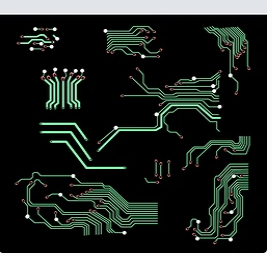This article focuses on a frontier category of communication products-microwave-level high-frequency circuits and their PCB circuit board design concepts and design principles. The reason why the PCB design principle of microwave-grade high-frequency circuit is chosen is that this principle has extensive guiding significance and belongs to the current high-tech hot application technology. The transition from the microwave circuit PCB design concept to the high-speed wireless network (including various access networks) projects is also connected in the same vein, because they are based on the same basic principle-the dual transmission line theory.
Experienced RF engineers design digital circuits or relatively low-frequency circuit PCBs, the first-time success rate is very high, because their design concept is based on "distributed" parameters, and the concept of distributed parameters in lower frequency circuits (including The destructive effect in digital circuits is often overlooked.

For a long time, the design of electronic products (mainly for communication products) completed by many peers has often been problematic. On the one hand, it is certainly related to the lack of necessary links in electrical design (including redundant design, reliability design, etc.), but more importantly, many such problems occur when people think that all necessary links have been considered. In response to these problems, they often spend their energy on the verification of procedures, electrical principles, parameter redundancy, etc., but seldom spend their energy on the review of PCB design, and often it is precisely because of PCB design defects that cause a lot of Product performance issues.
PCB design principles involve many aspects, including basic principles, anti-interference, electromagnetic compatibility, safety protection, and so on. For these aspects, especially in high-frequency circuits (especially in microwave-level high-frequency circuits), the lack of related concepts often leads to the failure of the entire R&D project. Many people still stay on the basis of "connecting electrical principles with conductors to play a predetermined role", and even think that "PCB design belongs to the considerations of structure, process and improving production efficiency." Many professional RF engineers have not fully realized that this link should be the special focus of the entire design work in RF design, and mistakenly spent energy on selecting high-performance components. As a result, the cost has risen sharply, but the performance improvement is minimal. .
It should be particularly pointed out here that the digital circuit relies on its strong anti-interference, error detection and correction, and the ability to arbitrarily construct various intelligent links to ensure the normal function of the circuit. An ordinary digital application circuit with high additional configuration of various "guarantee normal" links is obviously a move without a product concept. But often in the link that is considered "not worth it", it leads to product series problems. The reason is that this kind of functional links that are not worthy of reliability guarantee from the product engineering perspective should be based on the working mechanism of the digital circuit itself. It is only the wrong structure in the circuit design (including the PCB design) that causes the circuit to be in a state of failure. steady state. The cause of this unstable state is a basic application of the same concept as the similar problems of high-frequency circuits.
In digital circuits, there are three aspects worth taking seriously:
(1) The digital signal itself is a broad-spectrum signal. According to the results of the Fourier function, the high-frequency components contained therein are very rich, so the high-frequency components of the digital signal are fully considered in the design of digital ICs. However, in addition to the digital IC, the signal transition area within and between each functional link, if done arbitrarily, will cause a series of problems. Especially in circuits where digital and analog and high-frequency circuits are mixed.
(2) All kinds of reliability designs in digital circuit applications are related to the reliability requirements of circuits in actual applications and PCB product engineering requirements. It is not possible to add various high-cost "guarantees" to circuits that can fully meet the requirements using conventional designs. "part.
(3) The operating rate of digital circuits is moving towards high frequencies with unprecedented development (for example, the current CPU, whose main frequency has reached above 2GHz, far exceeds the lower limit of the microwave frequency band). Although the reliability guarantee function of related devices is also matched simultaneously, it is based on the internal and typical external signal characteristics of the device.